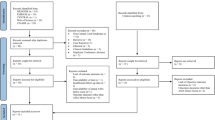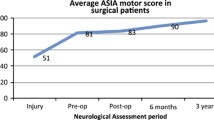Abstract
Purpose
This study compared the recovery of motor function and the safety of early and delayed surgical intervention in patients with central cord syndrome (CCS).
Methods
PubMed, Embase, Cochrane Library, and Web of Science were employed to retrieve the targeted studies published from inception to February 19, 2023. Comparative studies of early versus delayed surgical decompression in CCS based on American Spinal Injury Association motor score (AMS) recovery, complication rates, and mortality were selected. The statistical analyses were performed using STATA 16.0 and RevMan 5.4.
Results
Our meta-analysis included 13 studies comprising 8424 patients. Results revealed that early surgery improved AMS scores significantly compared with delayed surgery, with an increase in MDs by 7.22 points (95% CI 1.98–12.45; P = 0.007). Additionally, early surgery reduced the complication rates than delayed surgery (OR 0.53, 95% CI 0.42–0.67, P < 0.00001). However, no significant difference was observed in mortality between the two groups (OR 0.97; 95% CI 0.75–1.26; P = 0.84).
Conclusions
Early surgical decompression for CCS can improve motor function and reduce the incidence of complications without affecting the mortality rate in patients. Future research should focus on investigating and analyzing the optimal window period for early CCS surgery. Additionally, the timing of surgery should be determined based on the patient's condition and available medical resources.





Similar content being viewed by others
References
Zhang C, Lee VKH, Yu JML et al (2022) Length of cervical stenosis, admission ASIA motor scores, and BASIC scores are predictors of recovery rate following central cord syndrome. Spine 47:212–219
Jia Y, Zuo X, Zhang Y et al (2023) Effectiveness of different surgical methods in the treatment of acute central cord syndrome without fractures and dislocations of the cervical spine. J Back Musculoskelet Rehabil 36:71–77
Ramey WL, Reyes AA, Avila MJ et al (2021) The central cord score: a novel classification and scoring system specific to acute traumatic central cord syndrome. World Neurosurg 156:e235–e242
Zhou Q, Zhang J, Liu H et al (2022) Comparison of anterior and posterior approaches for acute traumatic central spinal cord syndrome with multilevel cervical canal stenosis without cervical fracture or dislocation. Int J Clin Pract 2022:5132134
Bortz C, Dinizo M, Kummer N et al (2021) Same day surgical intervention dramatically minimizes complication occurrence and optimizes perioperative outcomes for central cord syndrome. Clin Spine Surg 34:308–311
Aarabi B, Akhtar-Danesh N, Simard JM et al (2021) Efficacy of early (≤ 24 hours), late (25–72 hours), and delayed (> 72 hours) surgery with magnetic resonance imaging-confirmed decompression in American spinal injury association impairment scale grades C and D acute traumatic central cord syndrome caused by spinal stenosis. J Neurotrauma 38:2073–2083
Li J, Shi D, Hua Z et al (2021) The assessment of dynamic spinal cord impingement by kinematic magnetic resonance imaging in patients with traumatic central cord syndrome. Ther Clin Risk Manag 17:23–29
Badhiwala JH, Wilson JR, Fehlings MG (2019) Global burden of traumatic brain and spinal cord injury. Lancet Neurol 18:24–25
Thompson C, Mutch J, Parent S et al (2015) The changing demographics of traumatic spinal cord injury: an 11-year study of 831 patients. J Spinal Cord Med 38:214–223
Fehlings MG, Tetreault L, Nater A et al (2015) The aging of the global population: the changing epidemiology of disease and spinal disorders. Neurosurgery 77:S1–S5
Yoshihara H, Yoneoka D (2013) Trends in the treatment for traumatic central cord syndrome without bone injury in the United States from 2000 to 2009. J Trauma Acute Care Surg 75(3):453–458
Stevenson CM, Dargan DP, Warnock J et al (2016) Traumatic central cord syndrome: neurological and functional outcome at 3 years. Spinal Cord 54:1010–1015
Chen LF, Chang HK, Chen YC et al (2020) Five-year medical expenses of central cord syndrome: analysis using a national cohort. J Neurosurg Sci 64:147–153
Molliqaj G, Payer M, Schaller K et al (2014) Acute traumatic central cord syndrome: a comprehensive review. Neurochirurgie 60:5–11
Smith S, Somogyi R, Wright J, Lin C, Yoo J (2023) Surgery on the day of admission decreases postoperative complication rates for patients with central cord syndrome: an analysis of national surgical quality improvement (NSQIP) data from 2010 to 2020. Clin Spine Surg 36(5):E191–E197
Chen K, Nie C, Song H et al (2023) Early surgical intervention alleviates sensory symptoms following acute traumatic central cord syndrome. Eur Spine J 32:608–616
Badhiwala JH, Wilson JR, Harrop JS et al (2022) Early vs late surgical decompression for central cord syndrome. JAMA Surg 157:1024–1032
Liu G, Liu L, Wang Y (2022) surgical efficacy and prognostic factors for acute traumatic central cord syndrome without fracture and dislocation. Orthopedics 45:325–332
Samuel AM, Grant RA, Bohl DD et al (2015) Delayed surgery after acute traumatic central cord syndrome is associated with reduced mortality. Spine 40:349–356
Page MJ, McKenzie JE, Bossuyt PM et al (2021) The PRISMA 2020 statement: an updated guideline for reporting systematic reviews. BMJ 29:372
Ga Wells BS, O'connell D, Peterson J, et al. (2014) The Newcastle–ottawa scale (nos) for assessing the quality of nonrandomized studies in meta-analyses, Canada: Department of Epidemiology and Community Medicine, University of Ottawa. Available at: http://www.ohi.calprograms/clinicalepidemiology/oxfordasp
Qin C, Liu B, Wang Y, Su J, Zhang Y (2022) Impact of timing of surgery on traumatic central cord syndrome without fracture or dislocation. Interdiscip Neurosurg 28:101507
Zheng C, Zhu D, Zhu Y et al (2021) Early surgery improves peripheral motor axonal dysfunction in acute traumatic central cord syndrome: a prospective cohort study. Clin Neurophysiol 132:1398–1406
Chiu RG, Siddiqui N, Fuentes A et al (2020) Early versus late surgical intervention for central cord syndrome: a nationwide all-payer inpatient analysis of length of stay, discharge destination and cost of care. Clin Neurol Neurosurg 196:106029
Zheng C, Yu Q, Shan X et al (2020) Early surgical decompression ameliorates dysfunction of spinal motor neuron in patients with acute traumatic central cord syndrome: an ambispective cohort analysis. Spine 45:E829–E838
Godzik J, Dalton J, Hemphill C et al (2019) Early surgical intervention among patients with acute central cord syndrome is not associated with higher mortality and morbidity. J Spine Surg 5:466–474
Stevens EA, Marsh R, Wilson JA et al (2010) A review of surgical intervention in the setting of traumatic central cord syndrome. Spine J 10:874–880
Chen L, Yang H, Yang T et al (2009) Effectiveness of surgical treatment for traumatic central cord syndrome. J Neurosurg Spine 10:3–8
Guest J, Eleraky MA, Apostolides PJ et al (2002) Traumatic central cord syndrome: results of surgical management. J Neurosurg 97:25–32
Kumar AA, Wong JYH, Pillay R et al (2023) Treatment of acute traumatic central cord syndrome: a score-based approach based on the literature. Eur Spine J 32(5):13
Henninger B, Kaser V, Ostermann S et al (2020) Cervical disc and ligamentous injury in hyperextension trauma: MRI and intraoperative correlation. J Neuroimaging 30:104–109
Ros C, José-López R, Suñol A et al (2022) Central cord syndrome: clinical features, etiological diagnosis, and outcome in 74 dogs. J Am Vet Med Assoc 260:747–751
Hildebrandt G, Joswig H, Stienen MN et al (2022) Pros and cons of early and very early surgery for traumatic central cord syndrome with spinal stenosis: literature review and case report. J Neurol Surg A Cent Eur Neurosurg 83:57–65
Schroeder GD, Hjelm N, Vaccaro AR et al (2016) The effect of increased T2 signal intensity in the spinal cord on the injury severity and early neurological recovery in patients with central cord syndrome. J Neurosurg Spine 24:792–796
Aito S, D’Andrea M, Werhagen L et al (2007) Neurological and functional outcome in traumatic central cord syndrome. Spinal Cord 45:292–297
Kepler CK, Kong C, Schroeder GD et al (2015) Early outcome and predictors of early outcome in patients treated surgically for central cord syndrome. J Neurosurg Spine 23:490–494
Yamazaki T, Yanaka K, Fujita K et al (2005) Traumatic central cord syndrome: analysis of factors affecting the outcome. Surg Neurol 63:95–100
Lenehan B, Fisher CG, Vaccaro A et al (2010) The urgency of surgical decompression in acute central cord injuries with spondylosis and without instability. Spine 35:S180–S186
El Masry WS, Tsubo M, Katoh S et al (1996) Validation of the American spinal injury association (ASIA) motor score and the national acute spinal cord injury study (NASCIS) motor score. Spine 21:614–619
Shrosbree RD (1977) Acute central cervical spinal cord syndrome–aetiology, age incidence and relationship to the orthopaedic injury. Paraplegia 14(4):251–258
Ishida Y, Tominaga T (2002) Predictors of neurologic recovery in acute central cervical cord injury with only upper extremity impairment. Spine 27(15):1652–1658
Pollard ME, Apple DF (2003) Factors associated with improved neurologic outcomes in patients with incomplete tetraplegia. Spine 28(1):33–39
Epstein NE, Hollingsworth R (2015) Diagnosis and management of traumatic cervical central spinal cord injury: a review. Surg Neurol Int 6:S140–S153
Dahdaleh NS, Lawton CD, El Ahmadieh TY et al (2013) Evidence-based management of central cord syndrome. Neurosurg Focus 35:E6
Anderson KK, Tetreault L, Shamji MF et al (2015) Optimal timing of surgical decompression for acute traumatic central cord syndrome: a systematic review of the literature. Neurosurgery 77:S15–S32
Acknowledgements
None
Funding
Funding was provided by National Natural Science Foundation of the People’s Republic of China (Grant nos. 81973882, 81804119) and Beijing University of Chinese Medicine Science and Technology Innovation Project (Grant no. DZMKJCX-2023-010).
Author information
Authors and Affiliations
Corresponding authors
Ethics declarations
Conflict of interest
The authors declare that they have no conflict of interest.
Ethical approval
Not applicable. Since this paper is a meta-analysis and does not involve human researchers or animal experiments, ethical approval is not required.
Additional information
Publisher's Note
Springer Nature remains neutral with regard to jurisdictional claims in published maps and institutional affiliations.
Supplementary Information
Below is the link to the electronic supplementary material.
Rights and permissions
Springer Nature or its licensor (e.g. a society or other partner) holds exclusive rights to this article under a publishing agreement with the author(s) or other rightsholder(s); author self-archiving of the accepted manuscript version of this article is solely governed by the terms of such publishing agreement and applicable law.
About this article
Cite this article
Xu, L., Zhong, W., Liu, C. et al. Timing of decompression in central cord syndrome: a systematic review and meta-analysis. Eur Spine J (2024). https://doi.org/10.1007/s00586-024-08244-3
Received:
Revised:
Accepted:
Published:
DOI: https://doi.org/10.1007/s00586-024-08244-3




